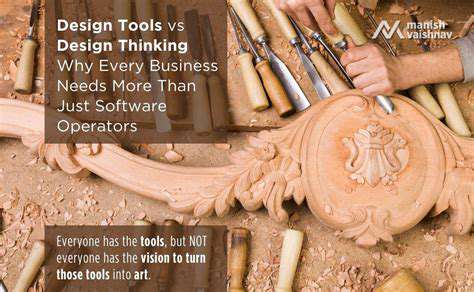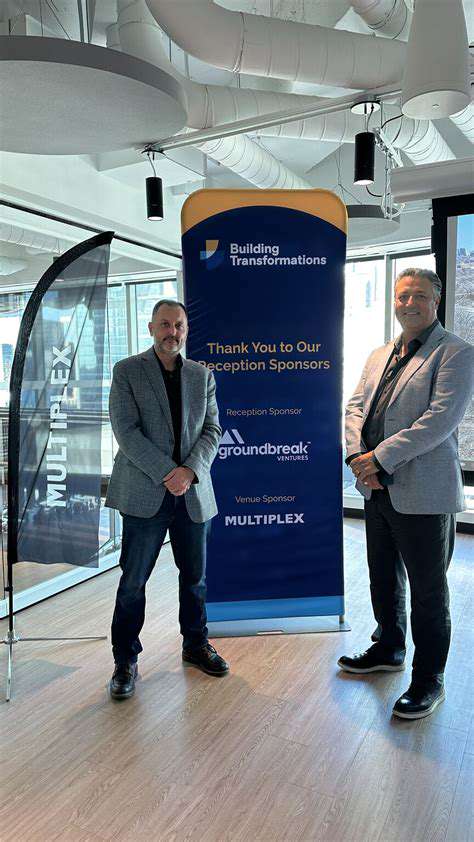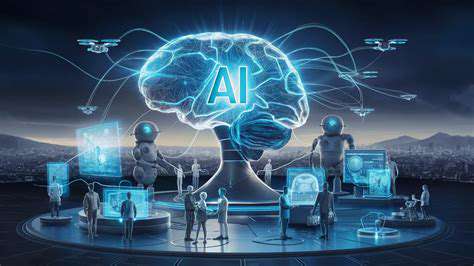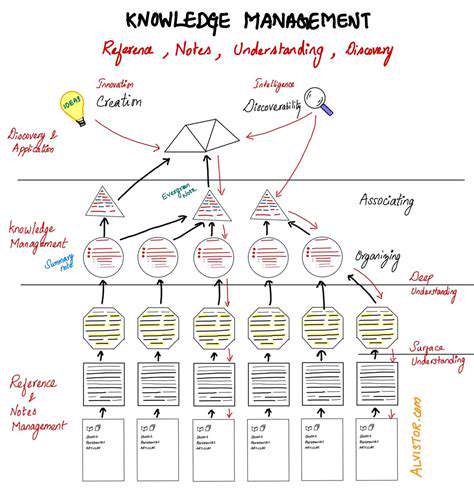The Future of Construction Tech (3D Printing, Robotics, Drones)
Early Applications and Prototyping
The initial applications of 3D printing in construction focused primarily on prototyping and small-scale models. This allowed architects and engineers to visualize complex designs, test structural integrity, and explore different material combinations before committing to large-scale projects. These early iterations demonstrated the potential of the technology, showcasing its ability to create intricate shapes and customized designs that were previously impossible or prohibitively expensive to achieve using traditional methods. The process proved valuable for evaluating feasibility and optimizing designs, ultimately leading to more efficient and cost-effective construction solutions.
Early adopters in the sector were often involved in niche projects, such as creating custom architectural elements or producing small-scale housing units. These pilot programs highlighted the technology's ability to generate unique and tailored solutions, providing a glimpse into the potential for personalized and sustainable construction practices. The early successes also spurred further research and development, leading to advancements in materials science and printing techniques, ultimately laying the foundation for the wider adoption of 3D printing in the construction industry.
Material Innovation and Sustainability
A key aspect of the rise of 3D printing in construction is the evolution of materials. Beyond traditional concrete and steel, researchers are exploring a wide range of materials that can be effectively 3D printed, offering new possibilities for sustainability and customized performance. This includes utilizing recycled materials, bio-based polymers, and composite materials, which can significantly reduce the environmental impact of construction projects.
These innovations are driven by the need for more sustainable and adaptable construction methods. The ability to print with diverse materials opens doors to creating structures that are tailored to specific environments and needs. For instance, 3D printing with bio-based polymers can contribute to a more eco-friendly approach, potentially reducing reliance on fossil fuels and minimizing waste. Furthermore, the use of recycled materials can lower the overall cost of construction and contribute to a circular economy.
Challenges and Future Prospects
Despite the significant advancements, challenges remain in the widespread adoption of 3D printing in construction. One major hurdle is the high cost of specialized equipment and the need for skilled operators. Furthermore, the regulatory framework and building codes need to adapt to accommodate the unique characteristics of 3D-printed structures. These challenges, while substantial, are not insurmountable and are actively being addressed by ongoing research and development initiatives.
Looking ahead, the future of 3D printing in construction appears promising. As the technology matures, the cost of equipment is expected to decrease, and the skills gap will likely be addressed through training and education programs. The potential for large-scale construction applications, such as creating entire buildings or infrastructure components, is substantial. The integration of 3D printing with other advanced technologies, such as AI and machine learning, promises to further streamline the design, construction, and maintenance processes.
Scaling Up for Large-Scale Applications
Scaling up 3D printing for large-scale construction projects requires overcoming logistical and operational hurdles. The current limitations in print speed and the ability to handle complex geometries need to be addressed for broader adoption. Researchers are actively investigating ways to improve printing speed, increase the size of build volumes, and enhance the handling of diverse materials. Further development in robotics and automation is crucial to optimize the construction process and make it more efficient.
The development of specialized 3D printing techniques tailored to different construction materials and applications is also essential. For example, developing techniques to print reinforced concrete or composite materials with intricate geometries will be critical for widespread adoption. The development of efficient and reliable quality control measures during the printing process will also be critical for ensuring the structural integrity and longevity of 3D-printed structures.
Beyond the Tools: The Impact on Design and Project Management

The Evolution of Design Thinking
Design thinking, a problem-solving approach rooted in understanding users, has significantly evolved over the years. It's no longer solely focused on aesthetics; instead, it's a multifaceted process encompassing empathy, experimentation, and iteration. This evolution has led to a deeper understanding of human needs and a more user-centered approach to problem-solving across various disciplines.
The shift from purely aesthetic considerations to a more holistic, human-centric approach has been crucial in driving innovation. This expanded perspective allows designers to create solutions that are not only visually appealing but also truly effective and impactful for the end-user.
The Human Element in Design
Understanding the needs and motivations of users is paramount in effective design. This involves more than just gathering superficial data; it requires truly empathizing with the people who will interact with the product or service. Qualitative research methods, like user interviews and ethnographic studies, become essential tools for gaining deep insights into user behavior and preferences.
By focusing on the human element, designers can create products and services that are not only functional but also meaningful and satisfying for users. This user-centric approach leads to a stronger connection between the design and the people it serves.
The Rise of Interdisciplinary Collaboration
Modern design projects often necessitate collaboration across various disciplines. This interdisciplinary approach brings together expertise in areas like engineering, marketing, and business to create a more comprehensive and holistic solution. By combining these diverse perspectives, designers can develop products that address the needs of users in a more nuanced and effective manner.
The synergy of different viewpoints fosters innovation and leads to creative solutions that might not have emerged from a singular perspective. Collaboration also helps ensure that the final product aligns with business goals and market demands, creating a win-win for all stakeholders.
The Impact on Business Strategy
Design thinking is no longer confined to the creative realm; it's increasingly integrated into business strategies. Companies are recognizing the value of design-led innovation in fostering creativity, adaptability, and ultimately, profitability. Strategic design thinking helps to identify new market opportunities and create products that resonate with target audiences.
By embedding design principles into the core of their business operations, companies can cultivate a culture of innovation and adaptability. This approach enables them to better respond to evolving market demands and stay ahead of the competition.
The Role of Technology in Facilitating Design
The proliferation of digital tools and technologies has significantly impacted the design process. Software applications and platforms offer designers powerful tools for prototyping, testing, and iterating on their ideas. This technological advancement has accelerated the design process and facilitated more efficient collaboration.
Technological advancements have not only streamlined the design workflow but also broadened the scope of what's possible. Designers can now experiment with complex interactions, explore diverse aesthetics, and create more sophisticated solutions than ever before.
The Future of Design in a Changing World
The future of design is intertwined with the ongoing evolution of technology and societal shifts. Designers will need to adapt to changing user needs, emerging technologies, and evolving cultural contexts. This necessitates continuous learning, adaptability, and a commitment to ethical considerations in design practices.
Designers must also embrace a proactive approach to addressing societal challenges and creating solutions that promote positive change. This involves understanding and responding to evolving global issues, such as sustainability, accessibility, and equitable design principles.
The Future of Construction: A Collaborative Ecosystem

The Rise of Automation in Construction
Automation is poised to revolutionize the construction industry, bringing about significant improvements in efficiency and productivity. Automated systems, such as drones and robotic arms, can perform tasks with greater precision and speed than human workers, leading to reduced construction time and lower labor costs. This technology will not only enhance the speed of building projects but also allow for more intricate and detailed designs to be executed with greater accuracy.
The implementation of prefabricated components and modular construction techniques is a direct result of automation's influence. This approach streamlines the construction process, reducing on-site labor and potential delays. The use of 3D printing is another promising advancement, enabling the creation of complex structures with unprecedented speed and accuracy.
Sustainable Practices and Green Building
The construction industry is increasingly focusing on sustainability and environmental responsibility. This includes the use of eco-friendly materials, energy-efficient designs, and strategies for reducing waste. Green building practices are not just environmentally conscious; they also offer long-term cost savings by minimizing energy consumption and reducing maintenance needs.
Adopting sustainable practices in construction is crucial for mitigating the industry's environmental footprint. This means incorporating renewable energy sources, using recycled materials, and optimizing energy efficiency measures in all stages of construction.
Advanced Materials and Technologies
The development of new and advanced materials is transforming the construction industry. These materials offer enhanced durability, strength, and resilience, allowing for the creation of more innovative and sustainable structures. Lightweight yet strong materials are reducing the overall weight of buildings, which translates into energy savings and reduced structural stress.
Nanotechnology, for example, is being explored for its potential to create self-healing concrete and other materials with enhanced properties. Smart materials that adapt to changing conditions are also emerging, offering the potential to create more responsive and efficient buildings.
The Impact of Digitalization
Digitalization is fundamentally altering the way construction projects are planned, managed, and executed. Building Information Modeling (BIM) is becoming increasingly prevalent, providing a virtual representation of the project, facilitating collaboration among stakeholders and improving communication. This technology allows for better coordination, reducing errors and potential conflicts during construction.
The use of cloud-based platforms and project management software is streamlining communication and information sharing among teams and stakeholders, leading to improved project planning, scheduling, and cost control. Real-time data access and analysis are enhancing decision-making during construction.
Improving Safety and Worker Well-being
Construction site safety is a top priority. New technologies and practices are being implemented to enhance safety protocols, reduce workplace hazards, and improve the overall well-being of construction workers. The use of wearable technology and sensors can monitor worker safety in real-time, enabling immediate intervention in case of potential hazards.
Implementing safety measures and creating a supportive work environment are essential for reducing accidents and ensuring the health and well-being of construction workers. This includes providing proper training and equipment, promoting safety awareness, and fostering a culture of safety within the construction workforce.
The Role of Skilled Labor in the Future
Despite automation's increasing role, skilled labor remains essential in the construction industry. Workers with specialized knowledge and expertise will be required to oversee, maintain, and troubleshoot automated systems and complex projects. The demand for skilled tradespeople, such as electricians, plumbers, and carpenters, will continue to be high as the industry evolves. Upskilling and reskilling initiatives are crucial to ensure that the workforce possesses the necessary competencies for the future of construction.
Challenges and Opportunities
While the future of construction holds immense potential, several challenges need to be addressed. One key challenge is integrating new technologies seamlessly with existing workflows and infrastructure. Ensuring that these advancements are accessible and affordable to all stakeholders is also critical to fostering widespread adoption. Addressing these challenges will unlock the full potential of innovation and drive positive change in the construction industry.
The construction industry must adapt to these changes to remain competitive and relevant in the evolving global landscape. By embracing new technologies, sustainability practices, and a focus on worker well-being, the industry can build a more efficient, sustainable, and prosperous future.
Read more about The Future of Construction Tech (3D Printing, Robotics, Drones)
Hot Recommendations
- Review: The New [Specific Brand] Smart Lock Is It Secure?
- Best Budget Studio Monitors for Music Production
- Top Flight Simulation Peripherals (Joysticks, Throttles, etc.)
- Top Portable Scanners for Document Management On the Go
- Reviewing the Latest Smart Air Purifiers for Your Home
- Best Portable Photo Printers for Travelers and Memory Keepers
- The Future of Personal Transportation Beyond Cars (Hyperloop, eVTOL)
- Top Network Monitoring Tools [Free & Paid Options]
- Understanding the Tech Behind mRNA Vaccines [A Look Inside]
- Guide to Choosing the Right Gaming Chair for Ergonomics











